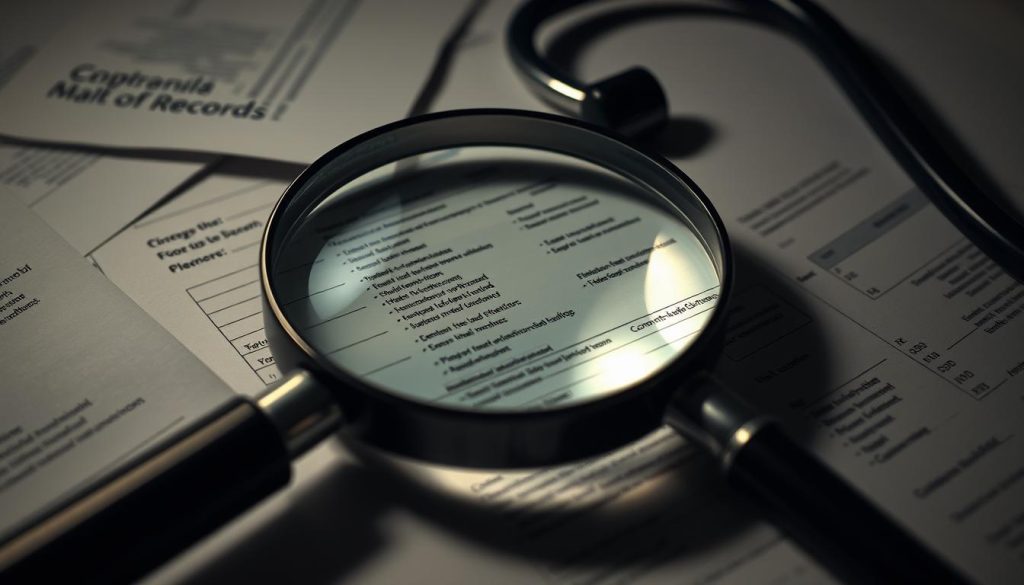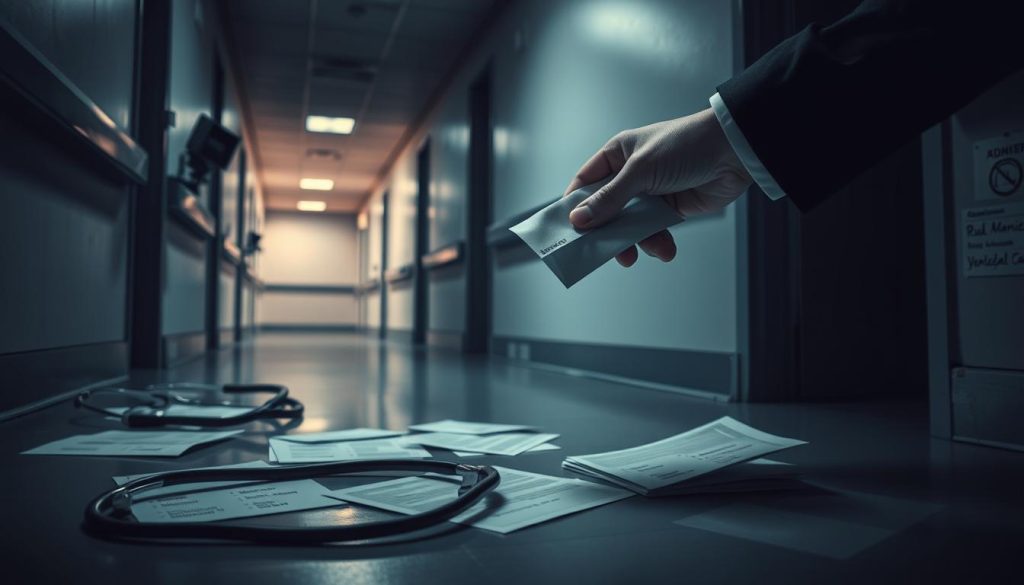In the complex world of healthcare, a troubling issue has been gaining attention – medical malpractice fraud. This insidious practice involves doctors and lawyers colluding to conceal evidence of medical negligence. This has devastating consequences for patients.
From inflated healthcare costs to eroded trust in the system, the impact of this fraud is far-reaching.
At the heart of this problem lies the alteration of medical records. This tactic is used by unscrupulous individuals to cover their tracks and avoid accountability. In this comprehensive article, we’ll explore the various types of medical malpractice fraud.
We’ll also look at the common schemes and tactics employed. And we’ll discuss the legal consequences faced by those who engage in these unlawful practices.
Key Takeaways
- Medical malpractice fraud costs the U.S. healthcare system between $58 billion and $83 billion annually.
- Fraudulent medical billing practices, such as upcoding and phantom billing, inflate healthcare costs and waste resources.
- Altered medical records can lead to increased insurance premiums and reduced access to care for patients.
- Healthcare providers and lawyers engaging in medical malpractice fraud face potential civil and criminal penalties.
- Patients who fall victim to medical malpractice fraud may suffer physical and emotional distress from unnecessary or harmful procedures.
- https://criminalinjurylaw.com/insurance-fraud-cases-the-thin-line-criminals-walk-in-injury-cases-8/
What is Medical Malpractice Fraud?
Medical malpractice fraud is when doctors or healthcare workers lie about medical info. They do this to hide mistakes or get money they don’t deserve. This can include things like false billing, kickbacks, and billing for services that weren’t given.
Types of Medical Malpractice Fraud
Doctors who commit fraud might change medical records or make up claims. They might alter when or what treatment was done. This is to trick patients, insurance, and courts.
Common Schemes and Tactics
Some common fraud tactics include:
- False medical billing: Billing for services not done.
- Kickback schemes: Getting money for patient referrals.
- Upcoding: Billing for more expensive procedures than done.
- Phantom billing: Billing for services or equipment not given.
- Altering medical records: Changing records to look like proper care was given.
- Forging documents: Creating fake medical records or documents.
- False claims: Making false statements to get money from insurance or government.
- Concealing mistakes: Hiding errors to avoid blame and keep getting paid.
Healthcare providers use these tricks to get money, hide mistakes, and avoid trouble.
Why Do Doctors Alter Medical Records?
Doctors altering medical records might seem like a way to protect themselves. But, it’s a serious legal consequence. Changing records is a crime that can lead to fines or jail time. It can also make records seem fake, which can hurt a doctor’s case in malpractice lawsuits.
Doctors who alter records risk losing their medical license. This is because it’s seen as dishonest.
Even with the risks, some doctors still change records to avoid malpractice lawsuits. Over 30 years, it’s been seen that doctors might alter records to hide mistakes, substance abuse, or to get paid for services not given. The pressure to meet goals can also lead to dishonesty.
The move to electronic medical records has made it harder to change records without being caught. This is especially true in hospitals. But, getting hospitals to share audit trail information can be hard. This is especially true in private offices where records are handwritten and can’t be tracked.
“Undated, illegible, incomplete, or wrong medical records can make it seem like care was bad. If it’s shown that records were changed without a good reason, it can hurt a doctor’s case. This might force doctors to settle cases they could have won.”
It’s important for any changes to medical records to be real, clearly marked, and done right. This avoids accusations of fraud or hiding the truth. The penalties for altering medical records are severe, including legal consequences and the chance of losing a medical license.
Detecting Altered Medical Records
It’s now easier to spot altered medical records thanks to new forensic tools and electronic health records (EHRs). Forensic experts use handwriting analysis and digital timestamps to find any changes. EHRs, with their audit trails, make it hard for providers to alter records without being caught.
Forensic Analysis and Digital Timestamps
Forensic analysis is key in spotting altered medical records. Experts look at handwriting and signatures for tampering signs. Digital timestamps also help by showing when changes were made, pointing out possible alterations.
Audit Trails in Electronic Health Records
EHRs have made it harder for providers to change records without being seen. They include audit trails that track changes, showing who made them and when. This makes it easier to spot any attempts to change or hide information.
| Technique | Description |
|---|---|
| Handwriting Analysis | Forensic experts can examine handwritten entries in medical records to identify any signs of tampering or forgery. |
| Digital Timestamp Analysis | By analyzing the timestamps associated with electronic record entries, experts can detect inconsistencies that may indicate alterations. |
| Audit Trail Review | The audit trail in electronic health records tracks all changes made to a patient’s records, making it easier to identify unauthorized modifications. |

These tools and techniques are vital in fighting medical malpractice fraud. They help ensure healthcare providers are responsible for any attempts to falsify or hide important medical info.
Legal Consequences of medical malpractice fraud
Healthcare providers who alter medical records face serious legal issues. This unethical act can lead to criminal charges, hefty fines, and even losing their medical license.
Criminal Charges and Fines
Falsifying medical records is a crime. Doctors and medical staff caught can face fines up to $5,000 and a year in jail. These harsh criminal charges can ruin a provider’s career and reputation.
Loss of Medical License
One of the worst outcomes is losing a medical license. In many states, including Maryland, altering records to hide negligence can lead to this. Without a license, finding work in medicine becomes nearly impossible.
“The loss of a medical license can effectively end a provider’s career, as it becomes extremely difficult to find employment in the field without a valid license.”
The legal system aims to hold healthcare providers accountable. It protects patients from bad care. By knowing the legal consequences, doctors are urged to keep records honest and clear. This ensures the best care for patients.

High-Profile Cases Involving Altered Medical Records
In recent years, several cases have shown healthcare providers altering medical records to hide malpractice. These cases show how serious this is and why accurate records are key.
In 2023, a Florida case led to a $4 million settlement. It was claimed that defense counsel altered a critical note in medical records. In 2022, a South Carolina woman sued a dentist for removing 16 teeth instead of 3. The dentist then changed her records to hide the mistake.
These are just a few examples. In 2021, a California court awarded $381,600 in a case of unauthorized access to medical records. In 2020, a Kentucky court gave a $5 million verdict for altered records after someone’s death.
Healthcare providers caught altering records face serious penalties. In Maryland, they can get fined up to $5,000 and jailed for a year.
Hospitals now use forensic analysis to spot altered records. They also use electronic health records (EHRs) and audit trails to prevent fraud.
Doctors are told to update records clearly to avoid legal trouble. HIPAA sets rules to protect and manage medical records, making fraud harder.
Sharing medical records online can be tricky due to different software and procedures. But, patients can get their records under HIPAA. However, the original documents stay with the healthcare facility, and copying them might cost.
These cases remind us of the dangers of medical malpractice fraud. It’s vital for healthcare providers, policymakers, and patients to work together. This ensures accurate records and protects patient rights as the healthcare world changes.
Conclusion
Medical malpractice fraud is a big problem that needs everyone’s attention. Healthcare providers and patients must stay alert. Knowing how fraudsters alter medical records helps protect you. This includes spotting signs of healthcare fraud.
Healthcare providers caught in fraud face serious penalties. They could lose their licenses and face criminal charges. This is why it’s crucial to watch out for any suspicious activity.
If you think your medical records have been tampered with, get legal help right away. Medical malpractice fraud can harm you a lot. It’s important to act fast to protect your health.
Being an active patient is key to avoiding fraud. Advocate for your care and check your records often. Together, we can make healthcare safer and more honest.
FAQ
What is medical malpractice fraud?
Medical malpractice fraud is when someone lies about medical information. This is often to hide mistakes or get money unfairly. It includes things like false billing and making up medical codes.
How do doctors and healthcare providers alter medical records?
Doctors who cheat might change medical records or forge documents. They might alter when a procedure happened or what was done. They do this to hide their mistakes and avoid being held accountable.
What are the legal consequences of altering medical records?
Changing medical records is a serious crime. It can lead to fines or even jail. It can also make a doctor lose their license.
How can altered medical records be detected?
Today, it’s easier to spot fake medical records. This is thanks to better forensic tools and electronic health records. Experts can find clues like handwriting changes or digital marks. EHRs also help track changes, making it harder to hide them.
What are the potential consequences for healthcare providers who engage in medical malpractice fraud?
Doctors who cheat face big penalties. They could get fined up to ,000 or jailed for a year. They might also lose their license, ending their career.
Can you provide examples of high-profile cases involving altered medical records?
Yes, there have been many cases where doctors were caught faking records. For example, in Florida in 2023, a million settlement was reached. It was over a changed medical note. In South Carolina in 2022, a woman sued a dentist for removing too many teeth. The dentist then altered her records to hide the mistake.

